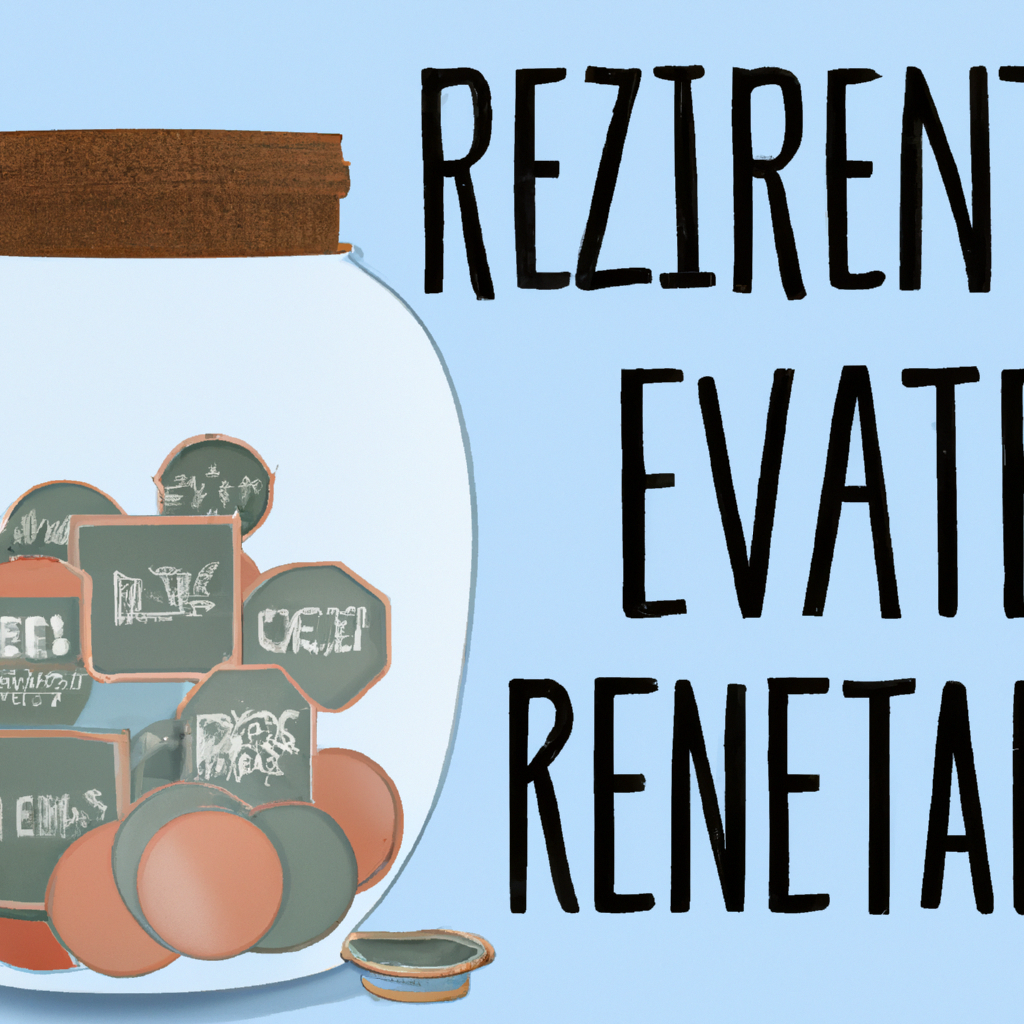Saving for retirement is an essential step towards securing a financially stable future, and contributing a fixed amount to your retirement savings each month can help you achieve that goal. By consistently setting aside a predetermined sum, you can gradually build a nest egg that will support you during your golden years. This article explores the importance of contributing to your retirement savings on a monthly basis and highlights the benefits it can bring in terms of long-term financial security and peace of mind. So, start taking control of your future today by making regular contributions to your retirement savings and ensuring a comfortable retirement awaits you.

Benefits of Contributing a Set Amount to Retirement Savings Each Month
Increase in Retirement Savings
By consistently contributing a set amount to your retirement savings each month, you can significantly increase the amount of money available to you when you retire. Regular contributions give your investments more time to grow, allowing you to take advantage of compound interest. Over time, this can result in a substantial increase in your total retirement savings.
Consistent Savings Habits
Contributing a set amount to your retirement savings each month helps you develop and maintain healthy savings habits. By making savings a priority and committing to regular contributions, you build discipline and responsibility regarding your financial goals. This consistency strengthens your overall financial well-being and sets you up for a secure retirement future.
Tax Advantages
One of the key benefits of contributing a set amount to retirement savings is the potential for tax advantages. Depending on the retirement account you choose, your contributions may be tax-deductible, allowing you to lower your taxable income. Additionally, some retirement accounts offer tax-deferred growth, meaning you don’t have to pay taxes on your investment gains until you withdraw the funds in retirement.
Compound Interest Benefits
Contributing a set amount to your retirement savings each month allows you to take full advantage of the power of compound interest. Compound interest is the interest earned on both the initial investment and the accumulated interest from previous periods. Over time, this compounding effect can significantly boost your retirement savings, as your money grows not only on the principal amount but also on the interest earned.
Determining the Set Amount for Retirement Savings
Assess Expenses and Income
To determine the set amount you should contribute to your retirement savings each month, it’s crucial to assess your expenses and income. Take a close look at your monthly expenses and evaluate areas where you can potentially reduce costs. Compare this to your income to get a clear understanding of how much you can comfortably allocate towards retirement savings.
Consider Future Needs
When determining your set retirement savings amount, it’s essential to consider your future needs and goals. Think about the kind of lifestyle you envision having during retirement and the expenses associated with it. Will you be traveling frequently, maintaining a mortgage, or funding any other significant costs? By taking these factors into account, you can better estimate the amount you’ll need to save each month.
Utilize Retirement Calculators
Retirement calculators can be excellent tools for determining the set amount you should contribute to your retirement savings each month. These calculators take into account various factors such as age, current savings, desired retirement age, and expected rate of return. By inputting this information, you can obtain an estimate of the monthly contribution required to meet your retirement goals.
Seek Professional Advice
If you’re unsure about determining the set amount you should contribute to your retirement savings, consider seeking professional advice. Financial advisors specialize in retirement planning and can provide personalized guidance tailored to your unique situation. They can help you assess your financial goals, evaluate your current financial position, and recommend an appropriate monthly contribution that aligns with your retirement objectives.
Setting Up Retirement Savings Contributions
Selecting the Right Retirement Account
When setting up your retirement savings contributions, it’s crucial to choose the right retirement account. Common options include employer-sponsored accounts like 401(k)s or individual retirement accounts (IRAs). Each type of account has its own advantages and restrictions, so it’s essential to research and consider factors such as contribution limits, tax advantages, and withdrawal rules before making a decision.
Understanding Contribution Limits
Contributing a set amount to your retirement savings each month requires an understanding of contribution limits. Different retirement accounts have varying limits on the amount you can contribute annually. For example, in 2021, the contribution limit for a 401(k) is $19,500 for individuals under 50 years old and $26,000 for individuals 50 and older. Be aware of these limits to ensure you adhere to the guidelines set by the IRS.
Choosing Automatic Contributions
To make contributing a set amount each month easier and more convenient, consider opting for automatic contributions. Many retirement accounts allow you to set up automatic transfers from your paycheck or bank account. By automating your contributions, you ensure consistency and eliminate the risk of forgetting to contribute. This approach also helps you stay committed to your retirement savings goals.
Monitoring and Adjusting Contributions
Setting up your retirement savings contributions is not a “set it and forget it” approach. Regularly monitoring and assessing your contributions is essential to ensure they align with your financial goals. As your financial situation changes or you approach retirement, you may need to adjust your monthly contribution amount. Stay proactive and review your contributions periodically to ensure you’re on track to meet your retirement objectives.
Building Habits for Regular Contributions
Make Retirement Savings a Priority
Building habits for regular contributions starts with making retirement savings a priority. Understand and prioritize the long-term benefits of saving for retirement, and make a conscious decision to allocate a set amount of your income towards it. By making it a priority, you shift your mindset and commitment towards securing your financial future.
Budgeting and Expense Management
To ensure you can consistently contribute a set amount to your retirement savings each month, it’s crucial to establish a budget and effectively manage your expenses. Track your spending, identify areas where you can reduce unnecessary costs, and allocate a portion of your income specifically towards retirement savings. By creating a realistic budget, you can better maintain regular contributions without straining your finances.
Establishing Realistic Savings Goals
Setting realistic savings goals is vital when building habits for regular retirement contributions. Assess your current financial situation, consider your long-term retirement goals, and determine a suitable monthly contribution amount. Be realistic about what you can comfortably afford to contribute, ensuring it doesn’t overly impact your day-to-day living expenses.
Automating Savings
Automating your retirement savings is a powerful strategy for building habits and ensuring regular contributions. Set up automatic transfers from your paycheck or bank account to your retirement savings account. By automating the process, you remove the temptation to spend that money elsewhere and establish consistent and reliable savings habits.

Strategies for Maximizing Retirement Savings
Take Advantage of Employer Matching
If your employer offers a matching contribution to your retirement account, take full advantage of it. Employer matching is essentially free money that boosts your retirement savings. Aim to contribute at least the amount required to receive the maximum matching percentage offered by your employer. By not taking advantage of this benefit, you’re essentially leaving money on the table.
Increasing Contributions Over Time
As your income grows, consider increasing your retirement contributions over time. Whenever you receive a raise or a bonus, allocate a portion of it towards your retirement savings. Gradually increasing your contributions allows you to consistently save more without significantly impacting your budget. This incremental approach can lead to substantial long-term growth in your retirement savings.
Consider Catch-Up Contributions
For individuals over 50 years old, catch-up contributions can provide an opportunity to maximize retirement savings. Catch-up contributions allow you to contribute additional funds beyond the regular contribution limits, potentially boosting your savings. Be aware of the specific catch-up contribution limits for your retirement account and take advantage of this opportunity if applicable.
Diversify Investment Portfolio
Diversification is a crucial strategy for maximizing retirement savings. Spread your investments across different asset classes such as stocks, bonds, and real estate to reduce risk and increase potential returns. Consider investing in low-cost index funds or mutual funds that provide broad exposure to various sectors and industries. Regularly review and rebalance your portfolio to ensure it remains aligned with your risk tolerance and long-term goals.
Managing Unexpected Financial Challenges
Emergency Savings Fund
While focusing on retirement savings, it’s important not to neglect the need for an emergency savings fund. Life often presents unexpected financial challenges, such as medical expenses or home repairs. By having a separate emergency fund, you can cover these unexpected costs without jeopardizing your retirement savings. Aim to save three to six months’ worth of living expenses in a liquid and easily accessible account.
Loan and Debt Repayment Strategy
Managing unexpected financial challenges requires a well-thought-out loan and debt repayment strategy. Prioritize high-interest debts and work towards paying them off as soon as possible. By reducing your debt burden, you free up more financial resources to allocate towards both emergency savings and retirement contributions. Consider seeking professional advice or debt consolidation options to efficiently manage and reduce your debts.
Reevaluating Expenses and Lifestyle
When faced with unexpected financial challenges, it’s crucial to reevaluate your expenses and lifestyle. Identify areas where you can cut back on discretionary spending and focus on essential expenses. By adjusting your lifestyle temporarily, you can allocate more resources towards overcoming financial challenges while still maintaining your retirement savings contributions.
Seeking Professional Guidance
If you find yourself in a challenging financial situation, it’s essential to seek professional guidance. Financial advisors can help you navigate unexpected challenges, develop a comprehensive plan, and make informed decisions about adjusting your retirement savings strategy. Their expertise can provide valuable insights and support during difficult times.

Monitoring and Adjusting Retirement Saving Strategies
Regularly Reviewing Account Performance
To ensure your retirement savings strategy remains on track, it’s important to regularly review your account performance. Keep a close eye on the growth of your investments and assess whether they align with your long-term goals. Monitor factors such as investment returns, fees, and asset allocation to determine if any adjustments need to be made.
Assessing Retirement Goals and Needs
Life is constantly changing, which means your retirement goals and needs may evolve over time. Regularly assess your retirement goals and determine if any adjustments are necessary. Consider factors such as changes in income, family circumstances, or desired retirement age. By staying proactive and adapting your goals as needed, you can ensure your retirement savings strategy remains relevant.
Adjusting Contributions Based on Life Changes
Life changes, such as marriage, having children, or purchasing a home, can significantly impact your financial situation. When these changes occur, it’s important to reevaluate your retirement contributions. Determine if an adjustment is necessary to accommodate these new financial responsibilities while maintaining progress towards your retirement goals.
Rebalancing Investment Portfolio
Regularly rebalancing your investment portfolio is crucial to maintain an appropriate asset allocation and manage risk. Market fluctuations can cause your portfolio to become unbalanced, with certain assets overperforming or underperforming. By periodically rebalancing, you can ensure your investments are aligned with your risk tolerance and long-term goals, improving the likelihood of achieving your desired retirement outcomes.
Planning for Retirement during Different Life Stages
Early Career Planning
During the early stages of your career, it’s important to establish a strong foundation for retirement planning. Start by contributing a set amount to your retirement savings each month, taking advantage of any employer matching contributions. Consider investing in higher-risk assets such as stocks, as you have more time to recover from potential market downturns. Continuously reassess your goals as your career and income progress.
Mid-Career Planning
As you progress in your career, reassess your retirement savings strategy and adjust your contributions accordingly. Maximize your retirement account contributions, taking advantage of catch-up contributions if you’re over 50. Evaluate your risk tolerance and consider diversifying your investment portfolio to balance potential returns and protect against market volatility. Revisit your retirement goals and make any necessary adjustments in anticipation of retirement.
Approaching Retirement Planning
Approaching retirement requires careful planning to ensure a smooth transition. Consolidate your retirement savings into a more conservative investment strategy that prioritizes capital preservation. Consider consulting with a financial advisor to develop a comprehensive retirement income plan, taking into account factors such as Social Security benefits, pension plans, and potential health care costs. Regularly reassess your retirement savings goals and make adjustments as needed.
Post-Retirement Planning
Even after retiring, it’s important to continue monitoring and managing your retirement savings. Establish a sustainable withdrawal strategy that balances your needs with the longevity of your funds. Review your investment portfolio regularly and adjust your asset allocation to maintain an appropriate level of risk. Keep track of any changes in tax laws or healthcare costs that may impact your retirement finances.

Understanding the Risks and Benefits of Retirement Investments
Market Volatility and Risk
Investing in the stock market comes with the inherent risk of market volatility. While the stock market has historically provided strong long-term returns, short-term fluctuations can result in a loss of value. It’s important to understand and accept the potential for market volatility, diversify your investments, and maintain a long-term perspective when it comes to your retirement savings.
Diversification and Asset Allocation
Diversification and asset allocation are essential components of a well-rounded retirement investment strategy. By spreading your investments across different asset classes, you can reduce risk and potentially increase returns. Diversification allows you to capture gains from various market sectors while mitigating losses in others. Asset allocation refers to the percentage of your portfolio allocated to different asset classes such as stocks, bonds, and cash.
Long-Term Growth Potential
One of the key benefits of retirement investments is the long-term growth potential they offer. By consistently contributing a set amount to your retirement savings each month and investing in a diversified portfolio, you can harness the power of compounding growth over time. Despite short-term market fluctuations, historically, the stock market has outperformed other investment options over the long run, providing potential for significant growth in your retirement savings.
Researching and Monitoring Investments
To make informed investment decisions for your retirement savings, it’s crucial to conduct thorough research and monitor your investments diligently. Stay updated on market trends, economic indicators, and the performance of individual companies and funds. Regularly review your investment portfolio and be prepared to make necessary adjustments based on changes in market conditions or your risk tolerance.
Conclusion
Contributing a set amount to your retirement savings each month offers numerous benefits that can help secure your financial future. By increasing your retirement savings, developing consistent savings habits, taking advantage of tax advantages, and harnessing the power of compound interest, you can build a solid foundation for a comfortable retirement. Determining the set amount for your retirement savings requires a careful assessment of your expenses and income, consideration of future needs, and potentially seeking professional advice or utilizing retirement calculators. Setting up your retirement savings contributions involves selecting the right retirement account, understanding contribution limits, opting for automatic contributions, and regularly monitoring and adjusting your contributions. Building habits for regular contributions involves making retirement savings a priority, effective budgeting and expense management, establishing realistic savings goals, and automating savings. Strategies for maximizing retirement savings include taking advantage of employer matching, increasing contributions over time, considering catch-up contributions, and diversifying your investment portfolio. Managing unexpected financial challenges requires an emergency savings fund, a loan and debt repayment strategy, reevaluating expenses and lifestyle, and seeking professional guidance. Monitoring and adjusting your retirement saving strategies involve regularly reviewing account performance, assessing retirement goals and needs, adjusting contributions based on life changes, and rebalancing your investment portfolio. Planning for retirement during different life stages involves early career planning, mid-career planning, approaching retirement planning, and post-retirement planning. Understanding the risks and benefits of retirement investments includes recognizing market volatility and risk, embracing diversification and asset allocation, acknowledging long-term growth potential, and conducting thorough research and monitoring investments. By implementing these strategies and considering these important factors, you can navigate your retirement savings journey with confidence and pave the way for a financially secure retirement.

